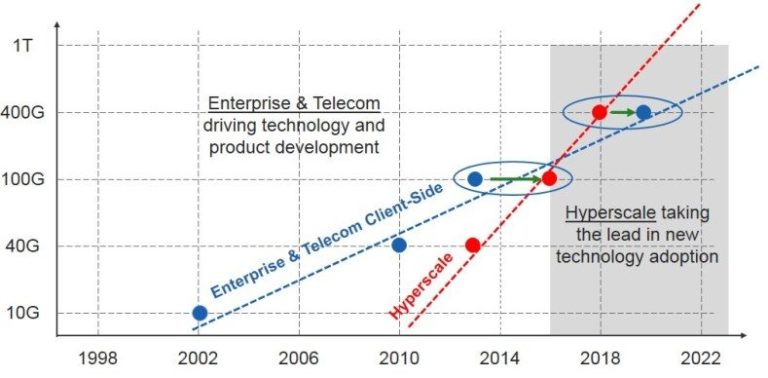The rapid expanding of data centers spurs the demand for higher speeds, greater scalability, and higher levels of performance over the network, and the demand is not gonna slack. Thus the Ethernet speed upgrade has become a hot topic. The past decades have witnessed the Ethernet speed transitions from 1G,10/25G to 40/100G. And the Ethernet industry continues to innovate to higher networking speeds like 200G and 400G. Well, is 400G Ethernet far in the future? The answer is “no”. This article will share some information about 400G Ethernet.
Overview of 400G Ethernet
400G Ethernet, or 400 Gigabit Ethernet (400GbE), is developed by IEEE P802.3bs Task Force in 2017. It uses broadly similar technology to 100 Gigabit Ethernet. However, 400G is not only four times as fast as 100GbE, but also provides a better economy of scale and a denser configuration. In addition, the new 400G products usually adopt 8 x 50G serial links, which are based on the latest PAM-4 module technology.
An Analysis on the 400G Market
Currently, 100G is the fastest Ethernet connections in broad adoption, which is growing steadily. However, with the continued boom in traffic, and the demand by video and other high-capacity data transfers, 400G Ethernet is an inevitable trend in data centers.

Figure 1: 400G Ethernet is an Inevitable roadmap for data centers
In terms of 400G transceiver module market, its driving forces relate primarily to the implementation of networks within the mega data centers and the interconnects between the data centers. It was reported that there were over 10 companies have demonstrated the 400G transceivers in OFC 2018. And these companies have planned to deploy 400G transceivers in data centers and Telecom in the end of this year. In addition, according to GLOBE NEWSWIRE, the global 400G transceiver market is expected to be at $22.6 billion in 2023.
In fact, some optical components for 400G Ethernet solutions have already been put into use such as 400G transceiver module, 400G Ethernet switch. What’s more, more and more vendors today join in the 400G Ethernet race, including Cisco, Juniper, Arista, Huawei, etc.
When it comes to 400G switches, Cisco is the leader in this field. It started shipping its new 400G switches in the end of 2018. Arista, Juniper, and other vendors come on the heels of Cisco. The race will be fiercer this year.
Except for 400G optical transceivers and 400G switches, other 400G components like 400G WDM, 400G AOC/DOC cables, etc. are on the way.
What’s New in Today’s 400G Optics Market?
Though 400G optics are not the mainstream in the market, there are more and more new 400G devices. The following will introduce some 400G optical transceivers and 400G switches in the market.
We know that the QSFP28 modules are for 100G Ethernet and SFP28 modules are for 25G Ethernet. Well, there are some transceiver modules for 400G Ethernet, including CFP8, QSFP-DD, OSFP, and COBO. The following are some popular 400G transceivers in the market.
400G CFP8 is the first-generation optical transceiver for 400G Ethernet applications. It usually allows for 16 x 25 Gb/s and 8 x 50 Gb/s mode, featuring a transmission length up to 10km.
QSFP-DD (Double Density QSFP) uses eight 25G lanes via NRZ modulation or eight 50G lanes via PAM4 modulation. What’s more, 400G QSFP-DD is able to backward compatible with QSFP modules that offers flexibility for end users and system designers.
OSFP means Octal Small Form Factor Pluggable. It has eight 50G lanes to support 400G like QSFP-DD but slightly wider and deeper than the QSFP module.
Unlike the above mentioned 400G transceivers, COBO (Consortium for On-Board Optics) is installed internally to the line-card equipment in a controlled environment. It is short of flexibility, but offers better power efficiency and higher port density. Therefore, COBO is regarded as the next-generation transceiver for 800G or beyond.
Nowadays, some 400G switches have already been put into use. For instance, 400G Nexus from Cisco, 7060X4 Series from Arista, Spectrum-2 from Mellanox, etc.
Cisco 400G switches contain 16-port Nexus 9316D-GX, 8-port Nexus 93600CD-GX, 4 RU Nexus 3408-S, and 32-port Nexus 3432D-S. These four Ethernet switches come with high-speed, high-performance, automation, visibility, assurance, and security functions to meet different architectural needs. In addition, Arista 7060X4 Series and Mellanox Spectrum-2 are also optimized for 400G Ethernet with developed features.
Summary
With the development of the network, 400G Ethernet will finally be the next major Ethernet speed for data centers, though there are still some challenges to overcome now, such as low power consumption and lower cost per bit. FS always keeps up with technology trends and provides reliable and cost-effective solutions. Now FS is planning to launch 400G Ethernet devices like 400G transceiver module. For more information, please visit www.fs.com.
Related Articles:
Global Optical Transceiver Market: Striding to 200G and 400G
FS.COM Is Ready to Devote to 400G Transceiver Market





